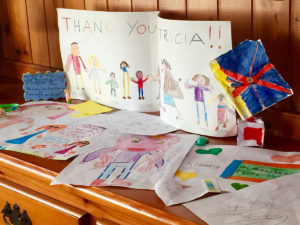Time to Leave: Reflections on the Adventures of Two English Tutors in Italy

Handmade thank you gifts from the elementary school children in Cipressa to Patti upon her departure.
We will take with us many, many wonderful memories of our time with the children, teachers, school staff and community at large. The restaurant owners have become friends, Pino, Ursella, Samantha, Don Pascuali to name a few.
The children are sad to see us go as we are to leave. We received handmade gifts, cards, and verbal sentiments that make it clear to us that the time we spent here was important.
What we take with us is also a clear understanding that Italy today is not our parents or grandparents Italy. It is not the Italy that we first visited 43 years ago or even the Italy we visited just a few years ago. Italy has changed, and the changes are significant.
The fact that Italy is no longer a homogeneous country it the most significant change. It has become very diverse. In our classes we had children from Peru, Morocco, Africa, Russia, Ireland, Germany, France, and Slovenia. We also had children who were Muslim, as well as Catholic in our classes. This level of diversity, especially in remote, small villages was unheard of in Italy years ago. It has opened Italy to a wide variety of perspectives and ideas.
Another change is in the attention to the environment. Italians have always been concerned about the purity of the food they eat, but not always as concerned about the environment in general. This is another change we have noticed. An example is that Italy as a nation has adopted a new recycling strategy. Every community, large and small, urban and rural is now recycling their trash into 5 distinct parcels which are picked up on a specified day each week – Organic waste, cardboard and paper, plastic, glass and general trash. This is a national directive and it is a significant change in culture. The bags are color coded and the change is evident wherever you travel within the country.
The economy and membership in the European Union has had its effect on Italy in subtle and not so subtle ways. One of the more subtle effects is that families do not have the multigenerational living arrangements that they have had in the past. Many elderly live alone, and young families live in nuclear units often with both parents working and children in school and day care. The Italy of years ago, when the children all went home for lunch and grandparents lived with young families is no more. Now, though some children still do go home for lunch, most stay and eat their lunch in school. The teachers that we worked with worry about the lack of supervision for many of the children as a result of these societal changes.
Fashion is another area where we noticed a change. Though fashion is still important to all Italians, we noticed a distinct change from formal to a more relaxed mode of clothing. One example is in footwear. Forty years ago it was unheard of to see Italians walking around in sneakers or to see women wearing flat shoes instead of heels. Today, everyone, young, old, male and female wear sneakers. This is still Italy, so make no mistake the sneakers are Moda (high fashion), with glitter, satin, bright colors and wedge soles. They are still sneakers and that is a significant difference in dress. It is rare to see women in high heels walking around the towns and villages now.
Also, for men in business the dress has become much less formal as well. Fewer men in business suites and many more less formal sport coats or dress shirts with-out neckties. Even the Italian Politicians in the news are dressed down rather than in more traditional business attire.
Something that hasn’t changed is the Italian love of dogs. Dogs are everywhere. They are in hotels, restaurants, and in stores. Every grocery store that we went into now has a special shopping cart for pets. It has a top and bottom section. The bottom section is for your groceries and the top section is lined with a plastic liner that is especially for dogs to sit in while their owners push them around and do their grocery shopping. The Italian relationships with their dogs is nothing new, but the demonstrations of it have clearly evolved!
Cycling has taken over in Italy! Everywhere you go, literally, you see cyclists on the roads. They travel alone, or in groups of two or ten. Sometimes they are followed by a support van but most of the time they are just out for the sport. On every road but the autostrada a you will find cyclists peddling their way throughout Italy.
Of course there are other important things about the Italian culture that have not changed – the Italian warmth, hospitality, pleasure in food and wine, and attention to artistic detail is still evident in all you do and see and experience in Italy and these are the things we continue to enjoy as we travel here.
Ciao for now! And thanks for joining us on these Adventures of two English Language Tutors in Italy.



Recent Comments